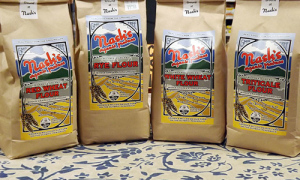
This recipe uses both triticale flour and regular white flour for superb texture.
Timeframe: 12-15 hours
1 1/2 cups sourdough starter
5 cups Nash’s Organic triticale flour
4 cups water
1/3 cup organic olive oil
1 tablespoon salt
4-6 cups organic unbleached white flour
Creating the Sponge
Combine: sourdough starter, water and Nash’s triticale flour in a large bowl, mix well and cover with a moist towel. Let this mixture sit at room temp for 8-12 hours. This is the sponge. A sponge is basically feeding the sourdough starter with fresh flour and water while creating a medium that will make the bread rise. When the surface is bubbly, scoop out 1 1/2 cups of the sponge and place in a clean jar with a lid and refrigerate. This is the starter for the next batch of bread.
Making the Sourdough Bread
Now that some sourdough starter has been saved for future batches, stir into the sponge the olive oil and salt. Next, fold in the unbleached white flour, 1 cup at a time, until a dough forms. At this point the dough will begin to pull away from the edges of the bowl. Remove from the bowl and place on a floured counter-top. Knead for 10-15 minutes, adding flour when necessary to keep the dough from sticking to the counter. Kneading is complete when it becomes difficult to add more flour and the dough easily holds its form in a ball. Once dough is thoroughly kneaded, divide into 2 or 3 pieces, depending on how large you would like your loaves to be. Place your loaves on an oiled cookie sheet or in bread pans, cover with a moist towel and let rise at room temperature for approximately 2 hours.
Preheat the oven to 400 degrees F. Sprinkle salt and make slits on the surface of the loaves. Place loaves in the preheated oven for 20 minutes. After 20 minutes turn the oven down to 375 degrees F and continue to bake for 45-60 minutes. When the surface and bottom of the loaves are well-browned remove from the oven and tap with a knuckle on the bottom of the loaf. If it makes a hollow sound, the bread is done. Place on cooling racks and enjoy.
We thank Eliza Winne for this recipe.
